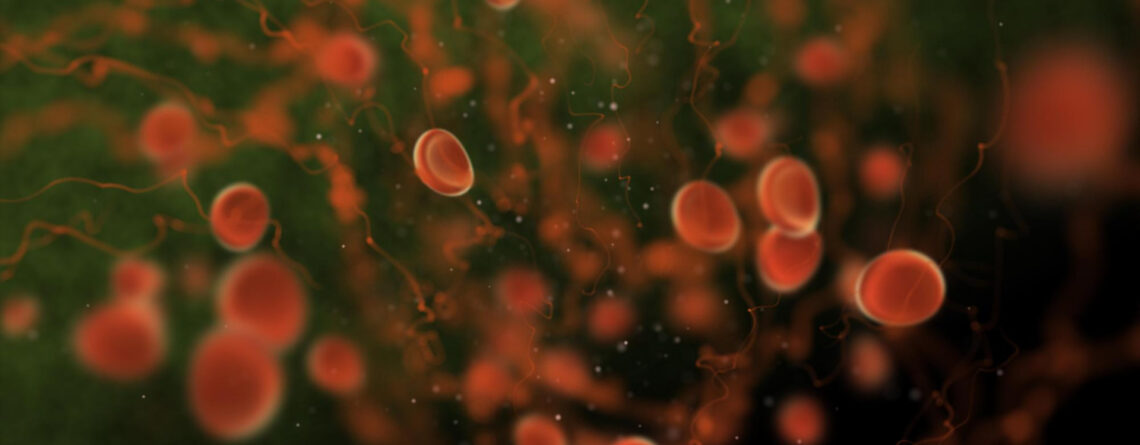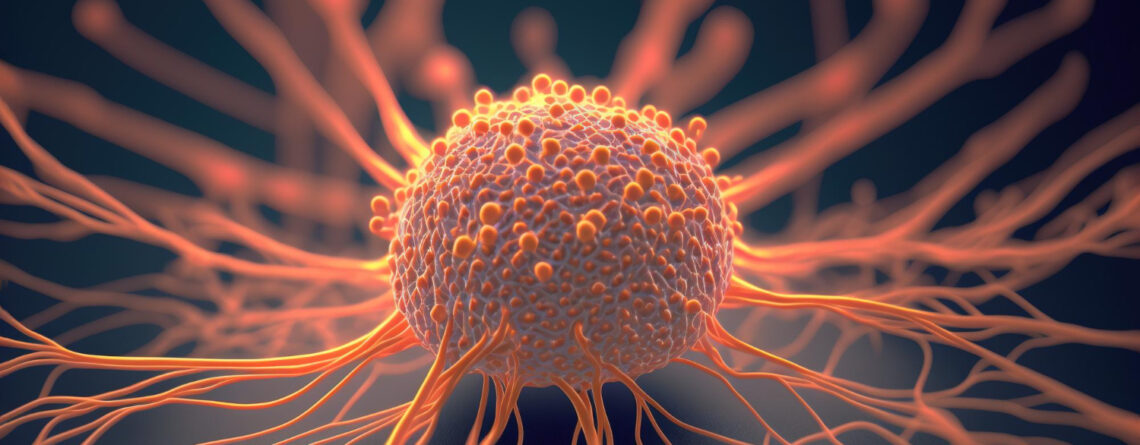Multiple myeloma (MM, myeloma disease, myeloma) is a malignant Hematology Oncology disease. Its basis is the uncontrolled proliferation and accumulation of defective monoclonal plasma cells that produce large amounts of immunoglobulins or only light chains of immunoglobulins (M-proteins). This is a malignant tumor, the morphological substrate of which is plasma cells that accumulate in the bone marrow and produce monoclonal antibodies (immunoglobulins).
The cause of the disease is unknown. The average age of MM onset is about 70 years. The incidence rate in Europe is 6 cases per 100 thousand population. Thanks to modern treatment methods introduction (new-generation drugs, immunobiological drugs, high-dose chemotherapy with hematopoietic stem cell transplantation) into myeloma treatment protocols. In recent years, medicine has achieved a breakthrough in the treatment of this disease and significantly improved the prognosis for patients.

Particularly good results are achieved in hematological oncological diseases treatment, including multiple myeloma, in Israel. That is why Maimonides Multidisciplinary Medical Center functionates in close cooperation with the best Israeli Hematology Oncology clinics, and we have chosen Israeli medicine as one of the most effective in the world as a model for providing medical services. In Hematology Oncology Department Maimonides Medical Center, each individual clinical case is jointly managed by hematologist oncologist, the head of the department in Ukraine, and the responsible hematologist oncologist directly from Israel. Thanks such a professional team, we succeeds even in the most difficult cases. Although all medical and diagnostic procedures are adapted to the realities of life in Ukraine, but take place under the close supervision of the best practicing doctors in Israel. Also, all our hematologists have undergone internships and appropriate training on the basis of well-known Israeli clinics.
The Maimonides Medical Center works under the patronage “Keren Or for our Child” the Charitable Foundation, so our patients can rely on financial assistance in serious illness treatment, if they cannot pay for it themselves.
All treatment methods applied by our specialists concerned their patients are based on modern world protocols and clinical recommendations, therefore, the quality of medical services cannot be doubted. At the same time, the approach to each patient is individual, because there are no two identical people or two identical diseases. Making up an examination plan and treatment regimen, doctor takes into account all the smallest details: age and sex, the main diagnosis, the stage of the disease, the characteristics of malignant cells, the presence of concomitant serious pathologies, and patient’s wishes regarding treatment. This approach significantly improves the results of complex treatment and has a positive effect on the prognosis.
An important treatment feature in Hematology Oncology Department of Maimonides Medical Center is a multidisciplinary approach. A patient with a hematological disease is assisted not only by hematologists, but by a whole team of highly qualified specialists – oncologists, chemotherapists, radiation therapists, surgeons, transplant specialists, hepatologists, rehabilitation specialists, and infectious disease specialists. Our medical center uses only modern and safe medical and diagnostic equipment of expert class. If a certain narrow specialist or rare medical and diagnostic equipment is not available, the patient is referred to subsidiary institutions of Maimonides Medical Center or our Israeli partner clinics, where he is guaranteed to receive the full range of necessary medical services, where he is guaranteed to receive the full range of necessary medical services.

Multiple myeloma causes and symptoms
The etiology of disease is unknown, although the role of such negative impact as chromosomal and genetic factors, radiation, and certain chemicals is currently being considered.
Multiple myeloma is a malignant plasma cell tumor that produces monoclonal immunoglobulins that penetrate from bone marrow into the adjacent bone tissue and destroy it. Characteristic manifestations include lytic bone lesions causing pain and/or fractures, renal failure, hypercalcemia, anemia, and recurrent infections. The most common manifestations are constant and long-lasting painin the bones (especially in the back or chest area ), kidney failure, recurren, bacterial, infections.
However, in most cases, the diagnosis is established by routine laboratory tests results that shows increased level of total protein in the blood, proteinuria, unexplained anemia, or renal failure.
However, in most cases, the diagnosis is established by routine laboratory tests results that shows increased level of total protein in the blood, proteinuria, unexplained anemia, or renal failure.
Pathological fractures (non-traumatic fractures or with minimal traumatic effects) are characteristic; spinal cord compression with the development of paraplegia may occur due to vertebrae damag. It should be noted that anemia in history can be predominant or only reason for a diagnostic search.
In a small number of cases, manifestations characteristic of blood hyperviscosity syndromeare observed. Typical symptoms are peripheral neuropathy, carpal tunnel syndrome (especially with accompanying amyloidosis), pathological bleeding, signs of hypercalcemia (polydipsia, dehydration). Kidney failure can also develop. Lymphadenopathy and hepatosplenomegaly are uncharacteristic.

Diagnosis Methods of Multiple Myeloma
As you know, the earlier the diagnosis of a malignant disease is established, the better prognosis and treatment result. Therefore, high-quality and quick diagnosis is an extremely important stage. Maimonides Medical Center applies only modern equipment of an expert class, all our doctors perfectly master all examination methods of multiple myeloma suspected patient, are able to interpret the received data without error. All of this helps them to create a modern, individual and effective treatment plan.
List of diagnostic tests:
- Complete blood count (CBC) with platelet count, peripheral blood smear, erythrocyte sedimentation rate (ESR) and biochemical blood analysis (urea, creatinine, calcium, uric acid, lactate dehydrogenase, etc.).
- Protein electrophoresis of blood serum and urine (daily urine collection) followed by immunofixation; quantitative determination of immunoglobulins; the level of free light chains in the serum.
- X-ray (skeletal examination) and positron emission tomography (PET)-CT or MRI of the whole body.
- Bone marrow studies including routine cytogenetic studies and fluorescence in situ hybridization (FISH).
An aspiration biopsy of the bone marrow is also performed . In biopsy, the presence of plasma cells located diffusely or in the form of clusters is revealed. The myeloma diagnosis is established in presence of more than 10% of cells this type. However, bone marrow involvement can be focal, so some samples from myeloma patients may show less than 10% plasma cells. In isolated cases, the number of plasma cells in bone marrow may be normal. The plasma cells morphology depends on the class of synthesized immunoglobulins. Bone marrow chromosome examination (for example, using genetic research methods such as FISH and immunohistochemistry) can show specific plasma cells karyotypic abnormalities, the presence of which is associated with differences in the patient's life expectancy.
Molecular genetic tests are used to detect certain types of malignant cells, as well as personalized immunotherapy selection (biological, targeted). An example of such modern diagnostics is systems for molecular genetic testing. Among them are th Foundation One and Caris Molecular Testing.
We send all materials after the biopsy to the world's best pathogistological laboratories (Israel, Germany, USA).). Thanks to such double checks, we are absolutely sure of diagnosis correctness and effectiveness of selected treatment tactics.
All necessary diagnostic procedures can be performed directly in the clinic, without leaving Ukraine.

Multiple Myeloma Modern treatment
One of the important treatment advantages of malignant blood diseases at Maimonides Medical Center is the application of a comprehensive approach to each individual clinical case. In struggle against the disease, doctor provide the entire available arsenal of methods. Therapy is always a combination of two, three, or even more methods. As a rule, the treatment regimen includes systemic drug chemotherapy in combination with radiation therapy and hematopoietic stem cell transplantation. In some cases, certain innovative methods of treatment are added to the treatment program (targeted drugs, immunobiological drugs, etc.).
The main treatment principles and methods of multiple myeloma are:
- In the past standard chemotherapy for patients with clinical manifestations of MM.
- Thalidomide, lenalidomide or pomalidomide and/or bortezomib, carfilzomib or ixazomib plus corticosteroids and/or standard chemotherapy.
- Monoclonal antibodies, including elotuzumab, isatuximab, and daratumumab.
- In relapsedor refractory myeloma – selective inhibitor of nuclear exportSINE) selinexor and histone deacetylase inhibitor panobinostat.
- In relapsedor refractory myeloma – Targeting B Cell Maturation Antigen (ВСМА) that is expressed on myeloma cells.
- Maintenance therapy with corticosteroids, thalidomide and/or lenalidomide and protease inhibitors, especially oral ixazomib.
- Radiotherapy of blood stem cells is possible.
- Radiotherapy Both remote radiation therapy with clinical manifestations that do not respond to systemic therapy is possible.
- Complications treatment (anemia, hypercalcemia, kidney failure, infections and bone lesions – especially those associated with a high risk of fractures).
In the past standard chemotherapy was initial therapy for multiple myeloma and consisted of oral melphalan and prednisone in cycles of 4 to 6 weeks for 8 to 12 cycles with monthly response assessment. However, better results have been achieved with the addition of a proteasome inhibitor such as bortezomib, carfilzomib, or ixazomib, or immunomodulators lenalidomide or thalidomide. Other chemotherapy drugs, including cyclophosphamide, bendamustine, doxorubicin, and its analogue liposomal pegylated doxorubicin, are also more effective in combination with an immunomodulatory drug (thalidomide, lenalidomide, or bortezomib). Clinical trials show better survival when initial treatment includes both bortezomib and lenalidomide with corticosteroids. Undoubtedly, the addition of the monoclonal antibody daratumumab to bortezomib and dexamethasone as initial treatment appears to improve outcomes.
Autologous stem cell transplantation can be used in patients with normal heart, liver, lung, and kidney function. This method is especially effective when the disease is stable or there is a response to treatment after several initial cycles of chemotherapy. However, research shows that new drug treatment options are very effective and transplantation may be needed less often or not at all.
Allogeneic stem cell transplantation is provided after chemotherapy (for instance, low-dose cyclophosphamide and fludarabine) or low-dose radiation therapy, and achieved relapse-free survival of 5 to 10 years in some patients.
In patients with relapsed or refractory myeloma may be used combinations of a proteasome inhibitor (bortezomib, ixazomib, or carfilzomib) with an immunomodulatory agent (eg, thalidomide, lenalidomide, or pomalidomide) and chemotherapy or corticosteroids. These drugs are usually combined with other effective drugs that the patient has not previously been treated with, although patients in long-term remission may respond to retreatment with the same regimen that led to the initial remission. Without response to a particular combination of drugs, a response is possible after switching to another drug of the same class (for example, proteasome inhibitors, immunomodulatory drugs, chemotherapy drugs).
Monoclonal antibodiesthat target myeloma cell proteins can also be highly effective in relapsed or refractory myeloma and include daratumumab, isatuximab, and elotuzumab. These antibodies are more effective in combination with lenalidomide or pomalidomide and dexamethasone.
Among new drugs that have shown their effectiveness are distinguished the selective inhibitor of nuclear exporter (SINE) selinexor and the inhibitor of histone deacetylase (HDACi) panobinostat. The new drugs are particularly effective in combination with other drugs active against myeloma. Recently become available two new drugs targeted on B-cell maturation antigen (B-cell maturation antigen). These drugs are the antibody conjugate belantamab mafodotin and the first cellular method of myeloma treatment – chimeric antigen receptor (CAR)-T-cell therapy idecabtagene vicleucel.
CAR-T cells therapy is the latest innovation in struggle against Hematology Oncology diseases, including multiple myeloma. Such drugs production requires a modern genetic engineering laboratory and highly qualified personnel. CAR-T cells are made individually for each patient. To do this, a blood sample is first taken from the patient, from which leukocytes are separated. Further, these leukocytes are modified through genetic engineering in such a way that chimeric antigen receptors ((CAR) appear on their surface in accordance with the type of tumor cells found in the same patient. Further, such "modernized" cells are multiplied by cloning and returned to the patient's blood, where they actively "track" them down and destroy them.
Radiotherapy helps suppress the growth of multiple myeloma and pain syndrome elimination. Our department uses the latest models of linear accelerators that irradiate malignant foci with high precision without touching healthy tissues.
Surgery s conducted in cases of compression-pain syndrome, when myeloma squeezes organs, nerves or vessels. For small tumors, surgeons provide minimally invasive interventions. After myeloma is removed, radiation therapy is usually given to kill any remaining cancer cells and prevent recurrence.
In each individual case , the decision on the combination of certain treatment methods is made jointly by a team of specialists. Each person and their disease is different, so our doctors, based on their experience in multiple myeloma treatment, often go beyond the standard protocols, changing the treatment regimens and doses of necessary drugs, radiation method in order to get the best possible results for their patients.
